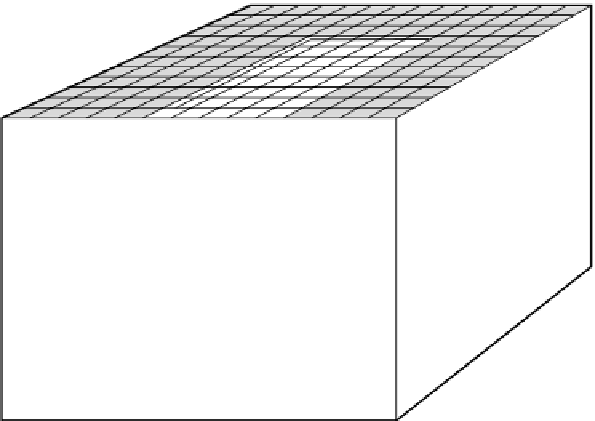Geology Reference
In-Depth Information
Shot lines
Recording
lines
Fig. 4.34
Reflected ray paths defining a
common depth point from an areal
distribution of shot points and detector
locations in a three-dimensional survey.
Reflector
CDP
induced by radio wave distortion in the atmosphere.
This can be corrected using a reference ground station of
known position. In this case the system is termed differ-
ential GPS (DGPS) and can give real-time accuracy to
within a few metres. In near-shore areas use may be
made of radio navigation systems, in which a location is
determined by calculation of range from onshore radio
transmitters. Doppler sonar may also be employed
to determine the velocity of the vessel along the survey
track for comparison with GPS satellite fixes (Lavergne
1989).
The areal reflector coverage obtained in three-
dimensional surveying provides the additional informa-
tion necessary to permit full
three-dimensional migration
in which reflection points can be migrated in any azimu-
thal direction. This ability fully to migrate three-
dimensional survey data further enhances the value of
such surveys over two-dimensional surveys in areas of
complex structure.
The essential difference between two-dimensional
and three-dimensional migration may be illustrated with
reference to a point reflector embedded in a homo-
geneous medium. On a seismic section derived from a
two-dimensional survey the point reflector is imaged as
a diffraction hyperbola, and migration involves sum-
ming amplitudes along the hyperbolic curve and plot-
ting the resultant event at the apex of the hyperbola (see
Fig. 4.31). The actual three-dimensional pattern associ-
ated with a point reflector is a hyperboloid of rotation,
Shot line
Recording
line
Subsurface
coverage
Fig. 4.35
The areal coverage derived from a single pair of crossing
lines in a three-dimensional survey. Each dot represents the mid-
point between a shot and a detector.
all shot-detector mid-points are accurately determined.
Position fixing is normally achieved using the global po-
sitioning system (GPS).The standard form of the system,
as now widely available in personal handsets, is not accu-
rate enough for seismic surveying due to the errors






































































